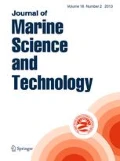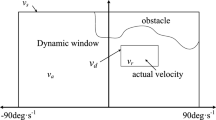Abstract
This paper focuses on a fuzzy logic based intelligent decision making system that aims to improve the safety of marine vessels by avoiding collision situations. It can be implemented in a decision support system of an oceangoing vessel or included in the process of autonomous ocean navigation. Although Autonomous Guidance and Navigation (AGN) is meant to be an important part of future ocean navigation due to the associated cost reduction and improved maritime safety, intelligent decision making capabilities should be an integrated part of the future AGN system in order to improve autonomous ocean navigational facilities. In this study, the collision avoidance of the Target vessel with respect to the vessel domain of the Own vessel has been analyzed and input, and output fuzzy membership functions have been derived. The if–then rule based decision making process and the integrated novel fuzzy inference system are formulated and implemented on the MATLAB software platform. Simulation results are presented regarding several critical collision conditions where the Target vessel fails to take appropriate actions, as the “Give way” vessel to avoid collision situations. In these situations, the Own vessel is able to take critical actions to avoid collisions, even when being the “Stand on” vessel. Furthermore, all decision rules are formulated in accordance with the International Maritime Organization Convention on the International Regulations for Preventing Collisions at Sea (COLREGs), 1972, to avoid conflicts that might occur during ocean navigation.

























Similar content being viewed by others
References
Fossen TI (ed) (1999) Recent developments in ship control systems design. World superyacht review. Sterling Publication Limited, London
Ohtsu K (1999) Recent development on analysis and control of ship’s motions. In: Proceedings of the 1999 IEEE international conference on control applications, Kohala Coast, HI, USA, pp 1096–1103
Healey AJ, Lienard D (1993) Multivariable sliding mode control for autonomous diving and steering of unmanned underwater vehicle. IEEE J Ocean Eng 18(3):327–339
Do KD, Pan J (2006) Robust path-following of underactuated ships: theory and experiments on a model ship. Ocean Eng 33(3):1354–1372
Moreira L, Fossen TI, Guedes Soares C (2007) Path following control system for a tanker ship model. Ocean Eng 34:2074–2085
Moreira L, Guedes Soares C (2008) H2 and H∞ designs for diving and course control of an autonomous underwater vehicle in presence of waves. IEEE J Ocean Eng 33(2):69–88
Rothblum AM, Wheal D, Withington S, Shappell SA, Wiegmann DA, Boehm W, Chaderjian M (2002) Key to successful incident inquiry. In: Proceedings 2nd international workshop on human factors in offshore operations (HFW2002), Houston, TX, pp 1–6
Antão P, Guedes Soares C (2008) Causal factors in accidents of high speed craft and conventional ocean going vessels. Reliab Eng Syst Saf 93:1292–1304
eNAV, eNavigation (2008) http://www.enavigation.org/
IMO (1972) Convention on the international regulations for preventing collisions at sea (COLREGs). http://www.imo.org/conventions/
Cockcroft AN, Lameijer JNF (2001) A guide to the collision avoidance rules. Elsevier Butterworth-Heinemann, Burlington
Chauvin C, Lardjane S (2008) Decision making and strategies in an interaction situation: collision avoidance at sea. Transp Res Part F: Traffic Psychol Behav 11(4):259–269
Sato Y, Ishii H (1998) Study of a collision-avoidance system for ships. Control Eng Pract 6:1141–1149
Lisowski J, Rak A, Czechowicz W (2000) Neural network classifier for ship domain assessment. Math Comput Simul 51:399–406
Pietrzykowski Z, Uriasz J (2009) The ship domain—a criterion of navigational safety assessment in an open sea area. J Navig 63:93–108
Kwik KH (1989) Calculations of ship collision avoidance manoeuvres: a simplified approach. Ocean Eng 16(5/6):475–491
Yavin Y, Frangos C, Zilman G, Miloh T (1995) Computation of feasible command strategies for the navigation of a ship in a narrow zigzag channel. Comput Math Appl 30(10):79–101
Sutulo S, Moreira L, Guedes Soares C (2002) Mathematical models of ship path prediction in manoeuvring simulation systems. Ocean Eng 29:1–19
Moreira L, Guedes Soares C (2007) Dynamic model of maneuverability using recursive neural networks. Ocean Eng 30(13):1669–1697
Smierzchalski R, Michalewicz Z (2000) Modeling of ship trajectory in collision situations by an evolutionary algorithm. IEEE Trans Evol Comput 4(3):227–241
Statheros T, Howells G, McDonald-Maier K (2008) Autonomous ship collision avoidance navigation concepts, technologies and techniques. J Navig 61:129–142
Ito M, Zhang F, Yoshida N (1999) Collision avoidance control of ship with genetic algorithm. In: Proceedings of the 1999 IEEE international conference on control applications, Kohala Coast, HI, USA, pp 1791–1796
Zeng X, Ito M, Shimizu E (2001) Building an automatic control system of maneuvering ship in collision situation with genetic algorithms. In: Proceedings of the 2001 American control conference, Arlington, VA, USA, pp 2852–2853
Hong X, Harris CJ, Wilson PA (1999) Autonomous ship collision free trajectory navigation and control algorithms. In: Proceedings of 1999 7th IEEE international conference on emerging technologies and factory automation (ETFA '99), Barcelona, Spain, pp 923–929
Cheng XD, Liu ZY, Zhang XT (2006) Trajectory optimization for ship collision avoidance system using genetic algorithm. In: Proceedings OCEANS 2006 - Asia Pacific, Singapore, pp 1–6
Liu Y, Liu H (2006) Case learning base on evaluation system for vessel collision avoidance. In: Proceedings of 2006 international conference on machine learning and cybernetics, Dalian, China, pp 2064–2069
Yang S, Li L, Suo Y, Chen G (2007) Study on construction of simulation platform for vessel automatic anti-collision and its test methods. In: Proceedings of 2007 IEEE international conference on automation and logistics, Jinan, pp 2414–2419
Zhuo Y, Hearn GE (2008) A ship based intelligent anti-collision decision-making support system utilizing trial manoeuvers. In: Proceedings of 2008 Chinese control and decision conference 2008 (CCDC 2008), Yantai, China, pp 3982–3987
Hardy TL (1995) Multi-objective decision-making under uncertainty: fuzzy logic method. NASA technical memorandum 106796, Computing in aerospace 10 meeting, San Antonio, TX, USA, pp 1–6
Hasegawa K (1987) Automatic collision avoidance system for ship using fuzzy control. In: Proceedings of 8th ship control system symposium, pp 234–258
Rommelfanger HJ (1998) Multicriteria decision making using fuzzy logic. In: Bezdek J, Hall LO (eds) Proceedings of conference of the North American fuzzy information processing society, Pensacola Beach, FL, USA, pp 360–364
Ozen T, Garibaldi JM, Musikasuwan S (2004) Modeling the variation in human decision making. In: Proceedings IEEE annual meeting of the fuzzy information processing, 04(2), pp 617–622
Lee S, Kwon K, Joh J (2004) A fuzzy logic for autonomous navigation of marine vehicles satisfying COLREG guidelines. Int J Control Autom Syst 2(2):171–181
Benjamin MR, Curcio JA, Newman PM (2006) Navigation of unmanned marine vehicles in accordance with the rules of the road. In: Proceedings of 2006 IEEE international conference on robotics and automation (ICRA 2006), Orlando, FL, USA, pp 3581–3587
Benjamin MR, Curcio JA (2004) COLREGS—based navigation of autonomous marine vehicles. IEEE/OES autonomous underwater vehicles, pp 32–39
Smeaton GP, Coenen FP (1990) Developing an intelligent marine navigation system. Comput Control Eng J 1:95–103
Perera LP, Carvalho JP, Guedes Soares C (2009) Decision making system for the collision avoidance of marine vessel navigation based on COLREGs rules and regulations. In: Proceedings of 13th congress of international maritime association of Mediterranean, Istanbul, Turkey, pp 1121–1128
Hasegawa K (2009) Advanced marine traffic automation and management system for congested waterways and coastal areas. In: Proceedings of international conference in ocean engineering (ICOE2009), Chennai, India, pp 1–10
Imazu H (2006) Advanced topics for marine technology and logistics. Lecture notes on ship collision and integrated information system. Tokyo University of Marine Science and Technology, Tokyo, Japan
Pedrycz W, Gomide E (2007) Fuzzy systems engineering—toward human centric computing. Wiley, Hoboken
Sivanandam SN, Sumathi S, Deepa SN (2007) Introduction to fuzzy logic using MATLAB. Springer, Berlin
Acknowledgments
The research work of the first author has been supported by the Doctoral Fellowship of the Portuguese Foundation for Science and Technology (Fundação para a Ciência e a Tecnologia) under contract SFRH/BD/46270/2008. Furthermore, this work contributes to the project “Methodology for ship manoeuvrability tests with self-propelled models”, which is being funded by the Portuguese Foundation for Science and Technology (Fundação para a Ciência e Tecnologia) under contract PTDC/TRA/74332/2006.
Author information
Authors and Affiliations
Corresponding author
About this article
Cite this article
Perera, L.P., Carvalho, J.P. & Guedes Soares, C. Fuzzy logic based decision making system for collision avoidance of ocean navigation under critical collision conditions. J Mar Sci Technol 16, 84–99 (2011). https://doi.org/10.1007/s00773-010-0106-x
Received:
Accepted:
Published:
Issue Date:
DOI: https://doi.org/10.1007/s00773-010-0106-x




